人教版七年级英语下册第五单元教案
- 格式:docx
- 大小:20.13 KB
- 文档页数:6
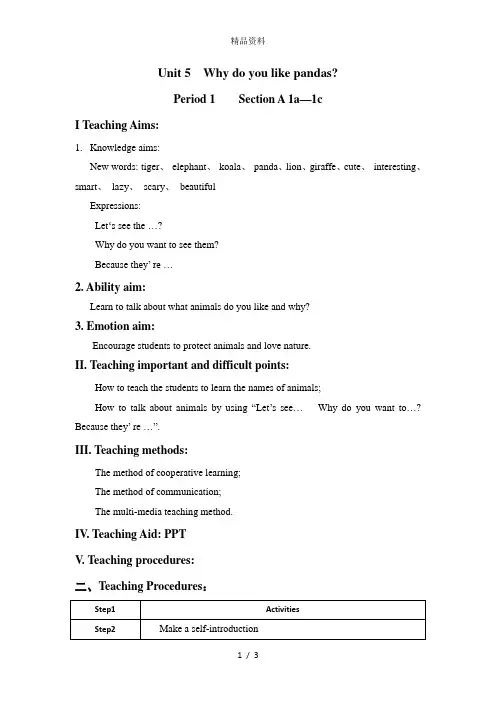

初中英语人教版七年级下册unit5sectionA(1a-2c)教案Unit5 SectionA(1a-2c)教案1.0 Teaching Analysis教情分析1.1 Teaching Objectives 教学目标1.1.1 Language goals 语言目标1.1.1.1 Key Words and Chunks1.1.1.1.1 For applying: panda, zoo, tiger, elephant, lion, giraffe,animal, cute, lazy, smart, beautiful, kind, kind of, Australia,south, South Africa1.1.1.1.2 For comprehending: koala, scary1.1.1.2 Sentence Structures1) Let’s see the panda first.2) Why do you want to see them?3) Because they’re interesting.4) Because they’re kind of interesting.5) Why don’t you like them?6) Where are they from?6) They are from China.7) I don’t like lions.1.1.1.3 Grammar Focus1.1.1.3.1 For applying:1) 形容词的基本用法作定语,放在名词之前。
Becky is a beautiful giraffe.做表语,放在系动词之后。
Mr Smith’s dog is cute and friendly.做宾语补足语,放在宾语之后。
Nice music makes me relaxing.2) why引导的特殊疑问句及回答why 引导的特殊疑问句,用来询问原因或者理由,一般由because引导的状语从句回答。
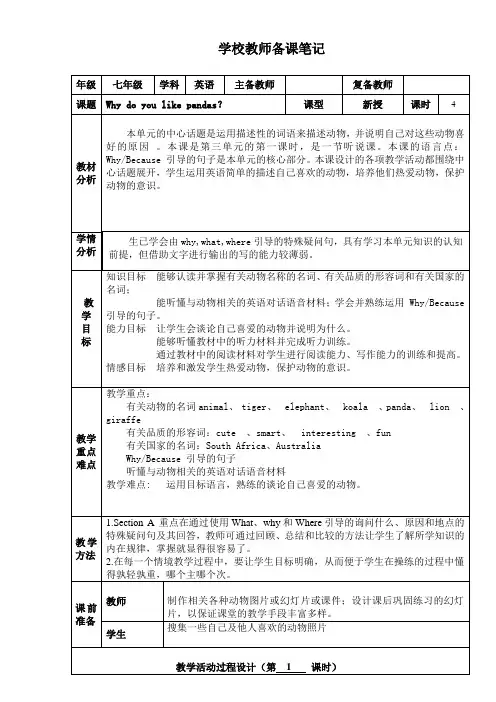

人教版新目标七年级英语下册 Unit 5 教案一. 教材分析人教版新目标七年级英语下册Unit 5主要讲述了日常生活中的一些活动,如游泳、打篮球、跳舞等。
本单元的话题贴近学生的生活,有利于激发学生的学习兴趣。
教材通过听说读写等多种活动,帮助学生掌握日常生活中的交际用语,提高学生的语言运用能力。
二. 学情分析七年级的学生已经掌握了基本的英语语法和单词,对于日常生活中的交际用语也有了一定的了解。
但部分学生可能在发音和口语表达上还存在困难,需要教师在教学中加以引导和纠正。
此外,学生可能对一些体育活动相关的词汇和表达不够熟悉,需要在课堂上进行拓展和练习。
三. 教学目标1.知识目标:学生能够掌握本单元的生词和短语,了解日常生活中的交际用语。
2.能力目标:学生能够听懂、会说、会读、会写与日常生活相关的英语句子。
3.情感目标:学生能够积极参与课堂活动,提高学习英语的兴趣。
四. 教学重难点1.重点:本单元的生词和短语,日常生活中的交际用语。
2.难点:情态动词can的用法,以及与日常生活相关的句型结构。
五. 教学方法1.任务型教学法:通过设置各种任务,让学生在完成任务的过程中学习英语。
2.情景教学法:创设各种生活情境,让学生在真实的环境中学习英语。
3.交际法:鼓励学生积极参与课堂交际,提高口语表达能力。
六. 教学准备1.准备单词卡片、短语卡片、图片等教学辅助材料。
2.准备与本单元话题相关的视频或音频材料。
3.准备课堂练习题和测试题。
七. 教学过程1.导入(5分钟)利用图片或视频引导学生谈论日常生活中喜欢的活动,引出本课话题。
2.呈现(10分钟)老师展示本课的生词和短语,让学生朗读并解释其意思。
同时,老师用情态动词can提问,引导学生回答。
3.操练(15分钟)学生分角色扮演,用情态动词can进行问答。
老师巡回指导,纠正发音和表达错误。
4.巩固(10分钟)学生完成课堂练习题,老师及时批改和讲解。
5.拓展(5分钟)老师引导学生谈论更多关于日常活动的表达,如游泳、打篮球、跳舞等。

人教版英语七年级下册《Unit 5 Why do you like pandas?》教学设计【教材分析】人教版英语七年级下册Unit 5 Why do you like pandas? 本单元的主题是通过谈论动物来熟练运用“why—because”句型提出疑问,解决问题。
通过对本单元的学习,学生能够对动物的性格及自己对动物的喜好的原因进行交流表达,并能够熟练运用“why—because”句型来询问他人的爱好,解释原因。
通过对动物的描述,让学生从从潜意识意识到动物的重要性,让学生自觉的爱护动物,保护动物,进而激发学生对大自然的保护意识,有利于帮助学生树立环保意识,增强环保观念。
【学情分析】我校地处城乡结合部,班级学生是以中等生为主的七年级新生,他们学习英语有很大的学习兴趣,有较强的记忆力和模仿能力,并有较强的求知欲和表现欲,因此课堂教学中我尽量让他们参与到活动中来,让他们有更多的机会来说英语用英语。
通过小组合作学习,体验自主学习的成功和喜悦。
【学习目标】1.知识与技能:A. 能掌握单词friendly shy及句型What animals do you like? I like elephants.B. 让学生学会谈论简单的动物及名称以及对动物的喜欢并说明为什么喜欢动物。
2.过程与方法:充分利用教材和多媒体教学所提供的学习资源,实现自由参与和创新,能主动与他人交流,在鼓励性评价中树立信心,在小组活动中积极参与合作,从而意识到交流对于学习英语的重要意义。
3.情感态度与价值观:通过本课学习,使学生有兴趣听说英语、做游戏,敢于开口,乐于模仿,恰当使用英语谈论简单的动物及名称以及对动物的喜欢并说明为什么喜欢动物,激发学生学习英语兴趣和保护环境的意识。
教学重点:让学生学习用形容词描述动物,从而说明自己喜欢某种动物的原因。
教学难点:让学生用句型What animals do you like? Why do you like ......? Because they are cute.等句型编对话。

Unit 5 Why do you like koalas?一、考点、热点回顾【重点单词】__________ adj、可爱得,机灵得__________ adj、懒惰得__________ adj、聪明得__________adj、美丽得,美好得__________ n、种类__________v & n、睡觉__________adj、友好得__________ adj、害羞得___________ v、拯救__________ v、忘记,遗忘__________ n、危险___________ prep、超过,多于【重点短语】________ 有点,稍微____________ 整天_________ 很,非常_________ 对…友好________ …中之一_____________ 处于危险之中____________ 砍到【重点句型】1.让我们去瞧熊猫吧。
____________ __________ the pandas___________、2.您为什么想瞧它们?_________ do you _________ _________ see them ?3.我非常喜欢老虎。
I _________ tigers __________ __________、4、难道她不美丽吗?__________ she ___________ ?【重点语法】:形容词与疑问副词why得用法(1)、形容词得概念形容词表示人或事物得性质,特征,特点等(2)、形容词得位置形容词作定语修饰名词时,要放在名词得前面eg:I have a lovely dog、但就是如果形容词修饰something, anything, nothing等不定代词时,要放在这些不定代词得后面。
如: There is something wrong with the bike、这辆自行车出毛病了。
(3)、形容词得用法除了可以作定语、表语、宾语补足语以外,有些形容词还可以与定冠词连用,表示一类人或事物,这时,它相当于一个名词,可以作主语或宾语。

Unit 5 Why do you like pandas?教学目标话题:动物园动物(Animal in a zoo)功能:1. 能描述各种常见动物(Describe animals)Pandas are kind of interesting.Lions are scary.The dog is really cute.The cat is kind of boring.2. 能表达自己对动物的喜好(Express preferences)A: Why do you like tigers? B: Because they’re really cool.语法:1. 能正确使用why, what和where引导的特殊疑问句进行回答(wh-questions and answers)A: Why do you like pandas? B: Because they’re kind of interesting.A: Where are lions from? B: They’re from South Africa.A: Why don’t you like tigers? B: Because they’re scary.2. 能正确使用表示性质和品质的形容词(Adjectives of quality)Your dog is really cute.He is very smart.She’s kind of boring.词汇和常用表达:1. 能正确使用以下词汇:panda, zoo, tiger, elephant, lion, giraffe, animal, kind,Australia, south, Africa, pet, leg, cat, flag, place, water, danger, tree, sleep, save, forget, cut, kill, cute, lazy, smart, beautiful, friendly, shy, down, over2. 能正确使用以下常用表达:kind of, South Africa, get lost, one of, be in (great)danger, cut down, (be) made of3. 能认读下列词汇:koala, scary, symbol, ivory, Thailand, Thai语音:1. 掌握以下音素的发音:/s/和/z/,/I z/,/ts/和/dz/2. 能划分句子的意群,并在朗读和表达时适当掌握停顿学习策略:1. 能借助上下文语境猜出部分词汇的含义2. 能根据词汇的含义、性质、特点等分类记忆单元词汇3. 能根据阅读语篇内容构建思维导图4. 能通过各种方式搜集有关动物的信息和资料文化知识:了解世界各地的典型动物Section A 1 (1a-2d)一、教学目标:1. 1) 能掌握以下单词:tiger, elephant, panda, lion, koala, giraffe, cute, lazy, smart,beautiful, scary, kind, kind of, Australia, south, Africa, SouthAfrica, pet, leg, cat, sleep2) 能掌握以下句型:①What animals do you/does she/ does he like?②Let’s see the …③Why do you/does she/ does he want to see …?④Because they are …2. ①To observe and describe animals.②To talk about their preferences③To know the implied meaning of some animals3. 动物和人类都生活在同一地球上,动物是我们的朋友。
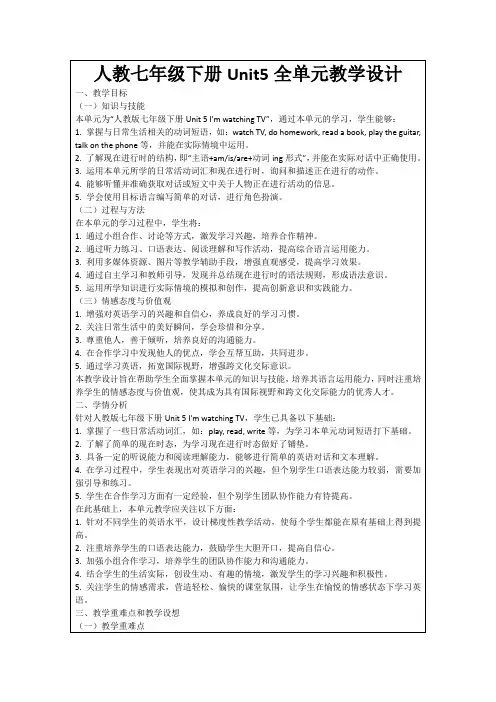
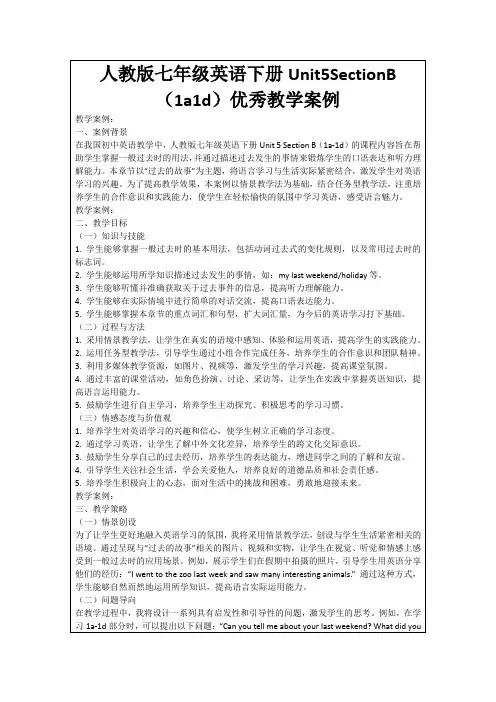

人教版新目标七年级英语下Unit5教案Unit 5 I’m watching TV第1课时一、学习目标1. 会读写25-26页单词2. 掌握句型-What are you/ they doing? -I’m / They’re watching TV.-What is she/he doing? -She /He is doing homework..3. 会用现在进行时谈论自己及别人正在做某事二、学习重点1. 学会用现在进行时的特殊疑问句来询问及回答自己及某人正在做某事2. 学会用现在进行时的一般疑问句来询问及回答自己及某人是否正在做某事三、学习过程(一)课前准备1.自己预习25-26页的单词和句子,不懂得地方做上标记,以便课上与同学们进行交流。
2.试做新方案36页课堂练习部分。
(二) 课堂活动1. 看1的图片和单词,把单词和图片搭配。
2. 听录音,完成1的听力。
3. 同学们分角色练习听力中的对话。
4. 学习成果展示:小组谈论某人正在做某事。
5. 再练习两个听力22练习,完成听力对话的内容。
6. 看2中的例句,仿造现在进行时的一般疑问句及回答。
7. 学习成果展示:两人用一般现在进行时的问句进行问答。
(三) 课堂练习1. What ______ you ______ (do) now?2. I’m _________ (eat) dinner .3. Look! What ______ Nancy______ (do)?4. She is _________ (write) a letter.5. Listen! What _________ they________(do)?四、学后反思本节课我学会了:我在学习中遇到的问题是:五、课后作业Unit 5 I’m watching TV第2课时一、学习目标1.讨论日常活动2.重点词组go to the movies去看电影write a letter 写一封信reading a book 看书3.目标用语1)-What are you doing? -I’m watching TV.2)-What’s she doing?-She’s read ing.二、学习重点现在进行时的用法三、学习过程(一)课前准备写出下列动词的现在分词1. do______2. watch ______3. write _____4. read ____5. take_____6. wait_____7. talk_____ 8. stop ______写出下列短语:⒈做作业___________ 2.去看电影_______________ 3.读书______________4.等待 ____________5.和某人谈话 _____________6.谈论 _____________(二)课堂活动【新课导入】复习目标语,为新课做准备。
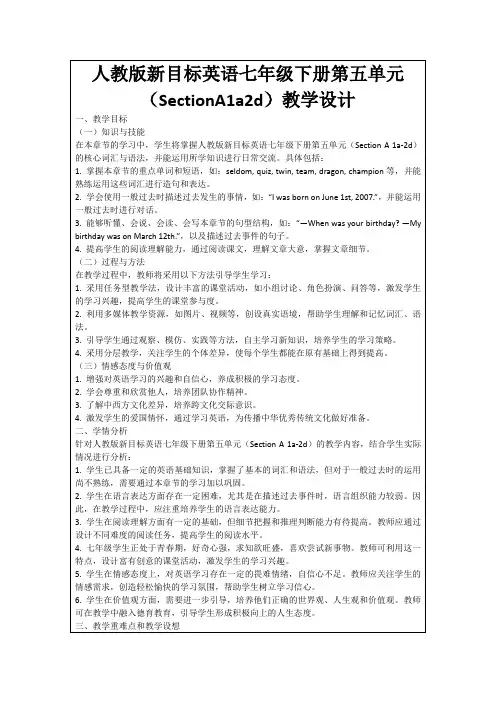
人教版新目标七年级英语下册 Unit 5 教学设计一. 教材分析人教版新目标七年级英语下册Unit 5主要围绕日常生活话题,通过学习本单元,学生能够掌握日常生活中的一些基本表达方式,提高他们的口语交际能力。
本单元的主要内容包括:询问和描述日常活动、表达喜好和意愿、谈论过去和将来的计划等。
本节课的主要目标是让学生能够熟练运用一般现在时进行日常交流。
二. 学情分析七年级的学生已经掌握了基本的英语语法和词汇,对日常生活中的常用表达有一定的了解。
但是,他们在口语表达和听力理解方面还存在一定的困难。
因此,在教学过程中,需要注重培养学生的口语交际能力和听力理解能力。
三. 教学目标1.能够熟练运用一般现在时进行日常交流。
2.能够听懂并正确回答关于日常活动的问题。
3.能够描述自己的喜好和意愿。
4.能够谈论过去和将来的计划。
四. 教学重难点1.一般现在时的运用。
2.日常英语表达的准确性。
3.听力理解的提高。
五. 教学方法采用交际法、任务型教学法和情境教学法。
通过设定真实的语境,让学生在实际交流中掌握语言知识,提高他们的口语交际能力和听力理解能力。
六. 教学准备1.教材:人教版新目标七年级英语下册。
2.教学多媒体课件。
3.教学卡片。
4.录音机和录音带。
七. 教学过程1.导入(5分钟)通过与学生谈论他们的日常活动,激发学生的学习兴趣,引导学生进入学习状态。
2.呈现(10分钟)利用多媒体课件和教学卡片,展示本节课的主要内容,让学生初步感知和理解。
3.操练(15分钟)通过小组活动和角色扮演,让学生在实际交流中运用所学知识,提高他们的口语交际能力。
4.巩固(10分钟)通过听力练习和口语交流,让学生进一步巩固所学知识,提高他们的听力理解能力。
5.拓展(10分钟)让学生谈论自己的喜好和意愿,以及过去和将来的计划,提高他们的语言运用能力。
6.小结(5分钟)对本节课的主要内容进行回顾和总结,让学生明确所学知识。
7.家庭作业(5分钟)布置作业:让学生运用一般现在时写一篇关于自己日常活动的短文。
人教版七年级下册英语Unit 5大单元教学整体教学设计一. 教材分析人教版七年级下册英语Unit 5主要围绕“家庭成员”展开,通过介绍家庭成员的名称、职业和爱好等,让学生掌握一般现在时的表达方式。
教材通过丰富的图片、情景对话和任务型活动,激发学生的学习兴趣,培养学生运用英语进行交际的能力。
二. 学情分析七年级的学生已经掌握了基本的英语语法和词汇,具备一定的听说读写能力。
但部分学生对家庭成员的英文表达和用法还不够熟悉,需要在课堂上进行针对性训练。
此外,学生对英语学习的兴趣和动机有待进一步提高。
三. 教学目标1.知识目标:学生能够掌握家庭成员的英文表达,学会用一般现在时介绍家庭成员的名称、职业和爱好等。
2.能力目标:学生能够在日常生活中运用英语进行家庭成员的介绍,提高口语交际能力。
3.情感目标:学生能够培养对英语学习的兴趣,增进与同学之间的友谊。
四. 教学重难点1.重点:家庭成员的英文表达和一般现在时的运用。
2.难点:家庭成员词汇的拓展和一般现在时在不同情境下的运用。
五. 教学方法1.情境教学法:通过设定生活情境,让学生在实际语境中学习、运用英语。
2.任务型教学法:引导学生参与各种任务,提高学生的实践能力和合作意识。
3.游戏教学法:通过趣味游戏,激发学生的学习兴趣,巩固所学知识。
六. 教学准备1.教学课件:制作课件,包含图片、视频、任务型活动等。
2.教学道具:准备与家庭成员相关的实物道具,如家庭成员照片、角色卡片等。
3.教学资源:收集一些关于家庭成员的英文资料,如文章、歌曲等。
七. 教学过程1.导入(5分钟)利用趣味游戏“猜猜我是谁?”引导学生谈论家庭成员,激发学生的学习兴趣。
教师出示一些家庭成员的图片,让学生用中文进行介绍。
2.呈现(10分钟)教师展示Unit 5的课件,引导学生关注标题“家庭成员”。
通过展示教材中的图片和情景对话,让学生整体感知课文内容。
同时,教师用中文解释一般现在时的概念,为学生接下来的学习做好铺垫。
Unit5 Why do you like pandas?Period 1 Section A(1a-2c)Teaching aims:1. Know the words about animals and their personalities.2. Enable the students to talk about and describe their favorite animals.3. Educate the students to love and protect animals.Key points:1. Master these words: zoo, animals, panda, tiger, elephant, koala, lion, giraffe, cute,beautiful, smart, lazy, scary, kind of, South Africa, Australia.2. Master the following sentence patterns:------ Why do you/don’t you like …?Why does /doesn’t he /she like …?Because they are …------ Where are … from?They are from …Teaching aids: a tape recorder, pictures, ppt.Teaching steps:Step One GreetingsSay Hello to the students.Step Two Lead-inPlay a short video for the students. What animals do you know?Step Three Presentation1. Teach new words with pictures.2. Present the following sentences with pictures.Why do you/don’t you like …?Because they are …Step Four ListeningPlay the recorder and ask students to do activity 1b.Step Five pair work.Show some pictures and a sample dialogue to the students, then ask them to make more conversations and act them out.A: Let’s see the lions.B: Why do you want to see them?A: Because they are interesting.cute interesting funsmart beautiful friendly shy…Step Six Work in groups. Ask and answerShow a sample dialogue to the students, then ask them to make more conversations and act them out.A:I like dogs. B:Why do you like dogs?A:Because they are cute and friendly.B: What animals does she like? Why does she like them?A:She likes panadas. Because they’re cuteStep 7 Listening1. Listen and complete 2a. Play the recorder twice, for the first time , students findout the animals they hear. Then they guess the description words and countries.Next, play the recorder for the second time and students to make sure theanswers.2. Listen and complete 2b.Step Seven Pair work1.Present a map of the world to teach new words and the new sentence pattern“Where are they from?”“They are from…”2. Show some pictures of animals and have students make conversations with thefollowing sentences:A: Let’s see…Do you like …? B:Yes, I do./ No, I don’t.A: Why do you/ don’t you like them? B: Because they are… .A: Where are they from? B: They are from… .3. Ask several pairs to show their conversations.Step Eight Survey1. Ask students to work in groups and do a survey.2. Fill in the chart about the survey .3. Ask students to do a report about their survey results.Step Nine Homework1. Make a list of the animals you know and try to describe each animal with a wordwe learnt in this class.2. Write an article about your favorite animals and describe their appearances, personalities, food, hobbies and where they are from.Period 2 Section A (1a-2c)Teaching aims:1. Know the words about animals and their personalities.2. Enable the students to talk about and describe their favorite animals.3. Educate the students to love and protect animals.Key points:1. Master these words: pet, leg, cat, sleep.2. Master the following sentence patterns:Why do you like pandas?Becau se they’re kind of interesting.Why does John like koalas?Because they’re very cute.Why don’t you like tigers?Why don’t you like tigers?Where are lions from?They’re from South Africa.Teaching procedures:Step 1: Review.1.Review the words: chant.2. Where are the animals from?Step 2 Work on 2d. Role-play.1.T: Some people like animals very much.They keep (=have养)an animal athome. We call the animals that we keep at home pets. (pet, cat,leg, sleep) T: What pets do people keep?2. Fast reading. Read the conversation and answer the questions.(1). What pet does Peter have?(2). What pet does Jenny’s mother have?3.Careful reading. Read again and answer the questions.(1). Does Peter like his dog?(2). What can the dog do?(3). Does Jenny like her mother’s pet? Why or Why not?4. Then Ss read the conversation in 2d5. Let some pairs role-play the conversation in 2d.Step 3 Grammar Focus.1.学生阅读Grammar Focus中的句子,然后做填空练习。
人教版七年级下册英语unit5整体单元教学设计English:In Unit 5 of the seventh grade English textbook of People's Education Press, the overall theme is "Celebrations". The unit integrates language points and communication tasks related to various celebrations, such as birthdays, New Year's Day, and cultural festivals. The unit aims to help students understand and use vocabulary related to celebrations, recognize and interpret simple written and spoken materials related to celebrations, and produce short written and spoken texts related to celebrations. The unit also focuses on developing students' abilities in listening, speaking, reading, and writing, as well as promoting their intercultural awareness and communication skills.中文翻译:在人教版七年级英语教材下册的第五单元中,整体主题是“庆祝活动”。
该单元整合了与生日、新年和各种文化节日等庆祝活动相关的语言要点和交际任务。
该单元旨在帮助学生理解和使用与庆祝活动相关的词汇,认识和解释与庆祝活动相关的简单书面和口头材料,并产生与庆祝活动相关的简短书面和口头文本。
Unit 5 Why do you like koalas一、考点、热点回顾【重点单词】__________ adj. 可爱的,机灵的 __________ adj. 懒惰的 __________ adj. 聪明的__________adj. 美丽的,美好的 __________ n. 种类 __________v & n. 睡觉__________adj. 友好的 __________ adj. 害羞的 ___________ v. 拯救__________ v. 忘记,遗忘 __________ n. 危险 ___________ prep. 超过,多于【重点短语】________ 有点,稍整天 _________ 很,非常 _________ 对…友好________ …中之一 _____________ 处于危险之中 ____________ 砍到【重点句型】1.让我们去看熊猫吧。
____________ __________ the pandas___________.2.你为什么想看它们_________ do you _________ _________ see them3.我非常喜欢老虎。
I _________ tigers __________ __________.4.难道她不美丽吗__________ she ___________【重点语法】:形容词和疑问副词why的用法(1).形容词的概念形容词表示人或事物的性质,特征,特点等(2).形容词的位置形容词作定语修饰名词时,要放在名词的前面eg:I have a lovely dog.但是如果形容词修饰something, anything, nothing等不定代词时,要放在这些不定代词的后面。
如:There is something wrong with the bike.这辆自行车出毛病了。
(3).形容词的用法除了可以作定语、表语、宾语补足语以外,有些形容词还可以和定冠词连用,表示一类人或事物,这时,它相当于一个名词,可以作主语或宾语。
如:rich(富裕的)--the rich(富人) old(老的)--the old(老人)We should help the poor.我们应该帮助穷人。
2.疑问副词why的用法1.由why引导的特殊疑问句why的意思是“为什么”,是个疑问副词,由它引导的特殊疑问句是用来询问原因的,其答语由because 引导。
如:-Why does he go to the hospital他为什么去医院-Because he is ill.因为他病了。
2.why还可以用于向别人提出建议,句型为“Why don't you+动词原形”或“Why not+动词原形”意为“为什么...不呢”如:Why don't you/Why not go for a walk为什么不去散步呢【课文重难点】(一)词汇:首先(1)序数词,意为“第一”。
(2)形容词,意为“首先的,最初的,第一的”。
(3)副词,意为“首先,最初”,置于句首或句尾。
如:First I'll tell you this.=I'll tell you this first.我先告诉你这个。
活学活用:1.单项填空When did you ______ meet himtime first2.汉译英让我们先做作业吧! __________________________________________.2.why为什么Why是疑问副词,用why提问的句子通常用because来回答。
活学活用:1.根据汉语意思完成句子-_________are you late again你为什么又迟到了-_________I am ill.因为我生病了。
2.对划线部分提问。
She likes parrots because they are smart._________ _________ she __________parrotsof有点儿,稍微【辨析】kind与kind of(1)kind是形容词,意为“亲切的,和蔼的”,有时可与friendly互换使用。
如:They are very kind/friendly to each other.他们彼此间很亲切。
(2)kind也可作名词讲,意为“种类、类型”。
常用短语:a kind of(一种,一类);different kinds of(不同种类的);all kinds of(各种各样的)。
如:I want to buy a kind of dress like yours.我想买一条你那样的裙子。
This bookshop has all kinds of books.这家书店有各种各样的图书。
(3)kind of常用于口语中,意为“有点儿,稍微”,如:I'm feeling kind of tired.我觉得有点儿累。
kind of相当于a little或a bit。
活学活用:单项填空computer is very nice,but _________of expensive.lot're different _________of pets in this animal market.4.other其它的,另外的【辨析】another,other,the other,others与the others(1)another指不定数目中的“另一个,又一个(三个或三个以上)”,一般用来代替或修饰单数可数名词。
如:I don't like this give me another.我不喜欢这一个。
请给我另一个。
(2)other意思是“另外的,其他的”,修饰复数名词。
如:What other animals do you like你还喜欢其他的什么动物吗(3)the other通常指两个中的“另一个”。
如:She has two is a teacher,the other is a doctor.她有两个女儿。
一个是教师,另外一个是医生。
(4)others泛指“另外的人或物”,相当于other后加复数名词。
如:Some people like swimming,and others like boating.一些人喜欢游泳,其他的人喜欢划船。
(5)the others特指某范围内的“其余全部的人或物”。
如:There are forty books in the are mine,and the others are my father's.箱子里有40本书。
其中有10本是我的,其余的都是我父亲的。
活学活用:1.单项填空I have two is black,and _______is white.other2.用another,other,the other,others或the others填空(1)I have two is green,___________________is red.(2)I don't like this yellow show me ________one.(3)She wants some_________books besides this dictionary.5.like喜欢like to do=like doing意为“喜欢做某事”。
如:Jack likes watching TV.=Jack likes to watch TV.杰克喜欢看电视。
【拓展】would like to do意为“想做某事”。
如:I would like to go swimming.我想去游泳。
活学活用:单项填空I don't like ______________late today.be D./也【拓展】too,either与also(1)too用在肯定句和疑问句的句末。
如:Jim likes like red,too.吉姆喜欢红色,我也喜欢红色。
(2)either常用在否定句中。
如:If he doesn't go,I won't,either.如果他不去,我也不会去。
(3)also用在肯定句句中,行为动词之前,be动词之后。
如:They also agree with me.他们也对我表示赞同。
Those books are also interesting.那些书也有趣。
活学活用:1.单项填空She is a mother is a doctor,______.2.改为否定句Jack knows the name of the know it,too.Jack _______ _________ the name of the ________,___________.(多少)岁;年纪【辨析】(1)old是形容词,age是名词。
(2)询问对方“多大年龄”用How old are you或What's your age活学活用:对划线部分提问My father is 40 years old.__________ __________is your father=____________is your __________ __________8.leaf叶子;树叶leaf复数形式是leaves。
活学活用:1.单项填空( )-What can you see in the picture-Some trees with ______ and some _______.;tomato ;tomatoes ;tomatos ;tomatos2.写出下列单词的复数形式(1)wife __________ (2)knife _____________(3)scarf__________ (4)life _____________睡觉【辨析】go to bed与sleep(1)go to bed指“上床睡觉”,强调动作,不含“睡着”之意。
如:We usually get up at six in the morning and go to bed at nine in the evening.我们通常在早上6点起床,晚上9点睡觉。
(2)sleep指睡、睡着的全过程。
如:Most of us work in the day and sleep at night.我们大多数人都在白天上班,晚上睡觉。
活学活用:汉译英(1)请安静!这个婴儿在睡觉。
__________________________________________(2)在学校,我们十点钟之前睡觉。